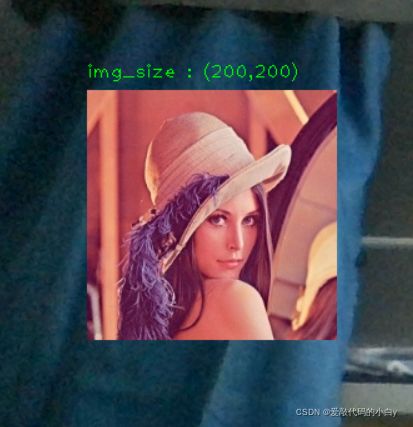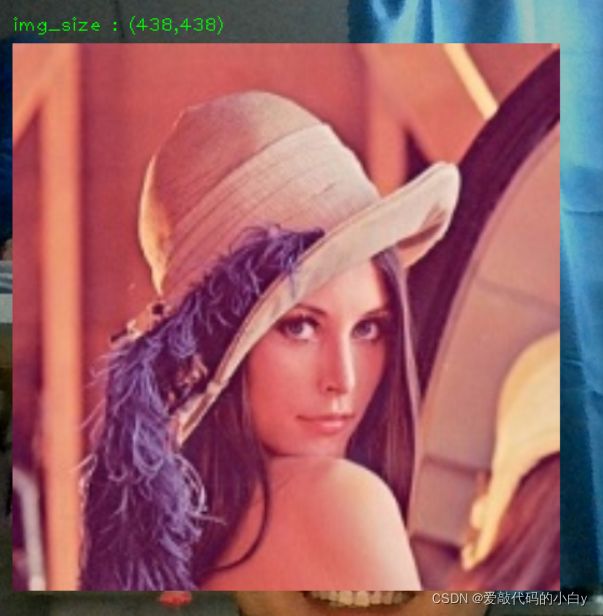利用opencv和mediapip实现对虚拟图像的多张缩放和移动
目录
一、 单张虚拟图像的缩放和移动
1.图片素材
2.代码如下:
3. 效果展示
二、多张虚拟图像的移动
1. 图片素材
2.代码如下:
3.效果如下:
三、多张图片缩放
1.代码如下:
2.效果如下:
四、多张图片的缩放和移动
1.代码如下:
2.效果如下:
提示:cvzone、mediapip的相关文档,参考:Hands - mediapipe
一、 单张虚拟图像的缩放和移动
1.图片素材
本次使用一张200*200的.jpg图片,
2.代码如下:
import cv2
from cvzone.HandTrackingModule import HandDetector
##########
wWin = 1300
hWin = 720
##########
cap = cv2.VideoCapture(0)
cap.set(3, 1300)
cap.set(4, 720)
startDistance = None
scale, cx, cy = 0, 200, 200
detector = HandDetector(maxHands=2, detectionCon=0.8)
while True:
ret, img = cap.read()
img = cv2.flip(img, flipCode=1)
# the data structure of hands: dictionary ,likes{"lmList","bbox","center","type"}
hands, img = detector.findHands(img, draw=True, flipType=False)
img1 = cv2.imread("lena.jpg")
if len(hands) == 2:
# Zoom Gesture
print(detector.fingersUp(hands[0]), detector.fingersUp(hands[1]))
if detector.fingersUp(hands[0]) == [0, 1, 0, 0, 0] and detector.fingersUp(hands[1]) == [0, 1, 0, 0, 0]:
lmList1 = hands[0]["lmList"]
lmList2 = hands[1]["lmList"] # List of 21 Landmarks points
# 8 is the tip of the index finger
if startDistance is None:
length, line_info, img = detector.findDistance(lmList1[8], lmList2[8], img)
startDistance = length
length, line_info, img = detector.findDistance(lmList1[8], lmList2[8], img)
scale = int((length - startDistance) // 2)
cx, cy = line_info[-2], line_info[-1]
else:
startDistance = None
# 异常处理
try:
h, w, _ = img1.shape
newH, newW = int((h + scale) // 2) * 2, int((w + scale) // 2) * 2
img1 = cv2.resize(img1, (newH, newW))
img[cy-newH//2:cy+newH//2, cx-newW//2:cx+newW//2] = img1
cv2.putText(img, text="img_size : " +"("+str(newH)+","+str(newW)+")"
, org=(cx-newW//2, cy-newH//2-10), fontFace=cv2.FONT_HERSHEY_PLAIN
, fontScale=1, color=(0, 255, 0), thickness=1)
except:
pass
cv2.imshow("Image", img)
if cv2.waitKey(1) & 0xFF == "q":
break
cv2.destroyAllWindows()
cap.release()3. 效果展示
缩放前:
缩放后:
二、多张虚拟图像的移动
1. 图片素材
先找两张.jpg文件,然后利用抠图软件扣去背景
抠图软件:创客贴-做图做视频必备_会打字就能做设计,商用有版权示
本次使用两张200*200的.jpg图片,
抠图后,生成.png图片
2.代码如下:
import os
import cv2
import cvzone
from cvzone.HandTrackingModule import HandDetector
##########
wWin = 1300
hWin = 720
##########
cap = cv2.VideoCapture(0)
cap.set(3, 1300)
cap.set(4, 720)
class DragImage():
def __init__(self, path, posOrigin, imgType):
self.path = path
self.posOrigin = posOrigin
self.imgType = imgType
if self.imgType == "png":
self.img = cv2.imread(self.path, cv2.IMREAD_UNCHANGED)
else:
self.img = cv2.imread(self.path)
self.size = self.img.shape[:2]
def update_oneHand_move(self, cursor):
ox, oy = self.posOrigin
h, w = self.size
# check if in the region
if (ox < cursor[0] < ox + w and oy < cursor[1] < oy + h):
self.posOrigin = cursor[0] - w // 2, cursor[1] - h // 2
path = "G:/2virtual_env python-learning-items/virtualZoom/img"
myList = os.listdir(path)
listImg = []
for index, pathImg in enumerate(myList):
if "png" in pathImg:
imgType = "png"
else:
imgType = "jpg"
listImg.append(DragImage(f"{path}/{pathImg}", [50+index*300, 50], imgType))
startDistance = 0
detector = HandDetector(maxHands=2, detectionCon=0.8)
while True:
ret, img = cap.read()
img = cv2.flip(img, flipCode=1)
# the data structure of hands: dictionary ,likes{"lmList","bbox","center","type"}
hands, img = detector.findHands(img, draw=True, flipType=False)
# load picture
try:
for imgObject in listImg:
h, w = imgObject.size
ox, oy = imgObject.posOrigin
if imgObject.imgType == "png":
# draw for PNG image
img = cvzone.overlayPNG(img, imgObject.img, [ox, oy])
if imgObject.imgType == "jpg":
# draw for JPG image
img[oy:oy+h, ox:ox+w] = imgObject.img
except:
pass
# when the index in the picture and the distance between index and middle is smaller than 60, move the picture
if len(hands) == 1:
lmList = hands[0]["lmList"]
# check if clicked
length, line_info, img = detector.findDistance(lmList[8], lmList[12], img)
if length < 60:
# restructure picture by the center of between index and middle
cv2.circle(img, (line_info[-2], line_info[-1]), 15, (0, 255, 0), cv2.FILLED)
cursor = line_info[4:]
for imgObject in listImg:
imgObject.update_oneHand_move(cursor)
cv2.imshow("Image", img)
if cv2.waitKey(1) & 0xFF == "q":
break
cv2.destroyAllWindows()
cap.release()3.效果如下:
三、多张图片缩放
1.代码如下:
import os
import cv2
import cvzone
from cvzone.HandTrackingModule import HandDetector
##########
wWin = 1300
hWin = 720
##########
cap = cv2.VideoCapture(0)
cap.set(3, 1300)
cap.set(4, 720)
class DragImage():
def __init__(self, path, posOrigin, imgType):
self.path = path
self.posOrigin = posOrigin
self.imgType = imgType
if self.imgType == "png":
self.img = cv2.imread(self.path, cv2.IMREAD_UNCHANGED)
else:
self.img = cv2.imread(self.path)
self.size = self.img.shape[:2]
def update_twoHand_Zoom(self, scale, cx, cy):
h, w = imgObject.size
ox, oy = imgObject.posOrigin
if (ox < cx < ox + w and oy < cy < oy + h):
newH, newW = int((h + scale) // 2) * 2, int((w + scale) // 2) * 2
self.size = newH, newW
self.posOrigin = [cx - newW // 2, cy - newH // 2]
self.img = cv2.resize(self.img, (newH, newW))
else:
pass
path = "G:/2virtual_env python-learning-items/virtualZoom/img"
myList = os.listdir(path)
listImg = []
for index, pathImg in enumerate(myList):
if "png" in pathImg:
imgType = "png"
else:
imgType = "jpg"
listImg.append(DragImage(f"{path}/{pathImg}", [50+index*300, 50], imgType))
startDistance = None
scale, cx, cy = 0, 0, 0
detector = HandDetector(maxHands=2, detectionCon=0.8)
while True:
ret, img = cap.read()
img = cv2.flip(img, flipCode=1)
# the data structure of hands: dictionary ,likes{"lmList","bbox","center","type"}
hands, img = detector.findHands(img, draw=True, flipType=False)
if len(hands) == 2:
# Zoom Gesture
print(detector.fingersUp(hands[0]), detector.fingersUp(hands[1]))
if detector.fingersUp(hands[0]) == [0, 1, 0, 0, 0] and detector.fingersUp(hands[1]) == [0, 1, 0, 0, 0]:
lmList1 = hands[0]["lmList"]
lmList2 = hands[1]["lmList"] # List of 21 Landmarks points
# 8 is the tip of the index finger
if startDistance is None:
length, line_info, img = detector.findDistance(lmList1[8], lmList2[8], img)
startDistance = length
length, line_info, img = detector.findDistance(lmList1[8], lmList2[8], img)
scale = int((length - startDistance) // 10)
cx, cy = line_info[-2], line_info[-1]
else:
startDistance = None
for imgObject in listImg:
h, w = imgObject.size
ox, oy = imgObject.posOrigin
if imgObject.imgType == "png":
# draw for PNG image
img = cvzone.overlayPNG(img, imgObject.img, [ox, oy])
if imgObject.imgType == "jpg":
# draw for JPG image
img[oy:oy + h, ox:ox + w] = imgObject.img
cv2.putText(img, text="img_size : " + "(" + str(imgObject.size[0]) + "," + str(imgObject.size[1]) + ")"
, org=(ox, oy-10),
fontFace=cv2.FONT_HERSHEY_PLAIN
, fontScale=1, color=(0, 255, 0), thickness=1)
try:
for imgObject in listImg:
imgObject.update_twoHand_Zoom(scale, cx, cy)
except:
pass
cv2.imshow("Image", img)
if cv2.waitKey(1) & 0xFF == "q":
break
cv2.destroyAllWindows()
cap.release()2.效果如下:
四、多张图片的缩放和移动
1.代码如下:
import os
import cv2
import cvzone
from cvzone.HandTrackingModule import HandDetector
##########
wWin = 1300
hWin = 720
##########
cap = cv2.VideoCapture(0)
cap.set(3, 1300)
cap.set(4, 720)
class DragImage():
def __init__(self, path, posOrigin, imgType):
self.path = path
self.posOrigin = posOrigin
self.imgType = imgType
if self.imgType == "png":
self.img = cv2.imread(self.path, cv2.IMREAD_UNCHANGED)
else:
self.img = cv2.imread(self.path)
self.size = self.img.shape[:2]
def update_twoHand_Zoom(self, scale, cx, cy):
h, w = imgObject.size
ox, oy = imgObject.posOrigin
if (ox < cx < ox + w and oy < cy < oy + h):
newH, newW = int((h + scale) // 2) * 2, int((w + scale) // 2) * 2
self.size = newH, newW
self.posOrigin = [cx - newW // 2, cy - newH // 2]
self.img = cv2.resize(self.img, (newH, newW))
else:
pass
path = "G:/2virtual_env python-learning-items/virtualZoom/img"
myList = os.listdir(path)
listImg = []
for index, pathImg in enumerate(myList):
if "png" in pathImg:
imgType = "png"
else:
imgType = "jpg"
listImg.append(DragImage(f"{path}/{pathImg}", [50+index*300, 50], imgType))
startDistance = None
scale, cx, cy = 0, 0, 0
detector = HandDetector(maxHands=2, detectionCon=0.8)
while True:
ret, img = cap.read()
img = cv2.flip(img, flipCode=1)
# the data structure of hands: dictionary ,likes{"lmList","bbox","center","type"}
hands, img = detector.findHands(img, draw=True, flipType=False)
if len(hands) == 2:
# Zoom Gesture
print(detector.fingersUp(hands[0]), detector.fingersUp(hands[1]))
if detector.fingersUp(hands[0]) == [0, 1, 0, 0, 0] and detector.fingersUp(hands[1]) == [0, 1, 0, 0, 0]:
lmList1 = hands[0]["lmList"]
lmList2 = hands[1]["lmList"] # List of 21 Landmarks points
# 8 is the tip of the index finger
if startDistance is None:
length, line_info, img = detector.findDistance(lmList1[8], lmList2[8], img)
startDistance = length
length, line_info, img = detector.findDistance(lmList1[8], lmList2[8], img)
scale = int((length - startDistance) // 10)
cx, cy = line_info[-2], line_info[-1]
else:
startDistance = None
for imgObject in listImg:
h, w = imgObject.size
ox, oy = imgObject.posOrigin
if imgObject.imgType == "png":
# draw for PNG image
img = cvzone.overlayPNG(img, imgObject.img, [ox, oy])
if imgObject.imgType == "jpg":
# draw for JPG image
img[oy:oy + h, ox:ox + w] = imgObject.img
cv2.putText(img, text="img_size : " + "(" + str(imgObject.size[0]) + "," + str(imgObject.size[1]) + ")"
, org=(ox, oy-10),
fontFace=cv2.FONT_HERSHEY_PLAIN
, fontScale=1, color=(0, 255, 0), thickness=1)
try:
for imgObject in listImg:
imgObject.update_twoHand_Zoom(scale, cx, cy)
except:
pass
cv2.imshow("Image", img)
if cv2.waitKey(1) & 0xFF == "q":
break
cv2.destroyAllWindows()
cap.release()





